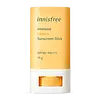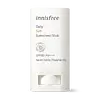What's inside
What's inside
 Key Ingredients
Key Ingredients

 Benefits
Benefits

 Concerns
Concerns

 Ingredients Side-by-side
Ingredients Side-by-side

Vinyl Dimethicone/Methicone Silsesquioxane Crosspolymer
Polyethylene
AbrasiveIsopropyl Palmitate
EmollientSilica
AbrasiveSynthetic Fluorphlogopite
Diethylamino Hydroxybenzoyl Hexyl Benzoate
UV FilterTocopheryl Acetate
AntioxidantOzokerite
Emulsion StabilisingBis-Ethylhexyloxyphenol Methoxyphenyl Triazine
Skin ConditioningDehydroacetic Acid
PreservativeTocopherol
AntioxidantWater
Skin ConditioningHamamelis Virginiana Leaf Extract
Skin ConditioningHouttuynia Cordata Extract
Skin ConditioningParfum
MaskingCurcuma Longa Root Extract
MaskingPropylheptyl Caprylate
EmollientBisabolol
MaskingPolyglyceryl-4 Diisostearate/Polyhydroxystearate/Sebacate
EmulsifyingCetyl Ethylhexanoate
EmollientEthylhexyl Palmitate
EmollientHelianthus Annuus Seed Oil
EmollientPropanediol
SolventCitric Acid
BufferingEthylhexyl Salicylate
UV AbsorberPolyurethane-11
Sodium Benzoate
MaskingEthylhexyl Methoxycinnamate
UV AbsorberButyloctyl Salicylate
Skin ConditioningLinalool
PerfumingLimonene
PerfumingVinyldimethicone
Triethoxycaprylylsilane
Benzotriazolyl Dodecyl P-Cresol
UV AbsorberEthylhexyl Triazone
UV AbsorberDicaprylyl Carbonate
EmollientPotassium Sorbate
PreservativeCentella Asiatica Extract
CleansingDistearyldimonium Chloride
Helianthus Annuus Seed Oil Unsaponifiables
EmollientButylphenyl Methylpropional
PerfumingPolysilicone-15
UV FilterEchium Plantagineum Seed Oil
Skin ConditioningSalvia Hispanica Seed Extract
EmollientSaccharide Hydrolysate
HumectantOctyldodecanol
EmollientBenzyl Salicylate
PerfumingDibutyl Adipate
EmollientDimethicone
EmollientCardiospermum Halicacabum Flower/Leaf/Vine Extract
Skin ConditioningHomosalate
Skin Conditioning1,2-Hexanediol
Skin ConditioningLauryl PEG-9 Polydimethylsiloxyethyl Dimethicone
Skin ConditioningPortulaca Oleracea Extract
Skin ConditioningVinyl Dimethicone/Methicone Silsesquioxane Crosspolymer, Polyethylene, Isopropyl Palmitate, Silica, Synthetic Fluorphlogopite, Diethylamino Hydroxybenzoyl Hexyl Benzoate, Tocopheryl Acetate, Ozokerite, Bis-Ethylhexyloxyphenol Methoxyphenyl Triazine, Dehydroacetic Acid, Tocopherol, Water, Hamamelis Virginiana Leaf Extract, Houttuynia Cordata Extract, Parfum, Curcuma Longa Root Extract, Propylheptyl Caprylate, Bisabolol, Polyglyceryl-4 Diisostearate/Polyhydroxystearate/Sebacate, Cetyl Ethylhexanoate, Ethylhexyl Palmitate, Helianthus Annuus Seed Oil, Propanediol, Citric Acid, Ethylhexyl Salicylate, Polyurethane-11, Sodium Benzoate, Ethylhexyl Methoxycinnamate, Butyloctyl Salicylate, Linalool, Limonene, Vinyldimethicone, Triethoxycaprylylsilane, Benzotriazolyl Dodecyl P-Cresol, Ethylhexyl Triazone, Dicaprylyl Carbonate, Potassium Sorbate, Centella Asiatica Extract, Distearyldimonium Chloride, Helianthus Annuus Seed Oil Unsaponifiables, Butylphenyl Methylpropional, Polysilicone-15, Echium Plantagineum Seed Oil, Salvia Hispanica Seed Extract, Saccharide Hydrolysate, Octyldodecanol, Benzyl Salicylate, Dibutyl Adipate, Dimethicone, Cardiospermum Halicacabum Flower/Leaf/Vine Extract, Homosalate, 1,2-Hexanediol, Lauryl PEG-9 Polydimethylsiloxyethyl Dimethicone, Portulaca Oleracea Extract
Isopropyl Palmitate
EmollientButylene Glycol Dicaprylate/Dicaprate
EmollientPolyethylene
AbrasiveC12-15 Alkyl Benzoate
AntimicrobialPolymethylsilsesquioxane
Vinyl Dimethicone/Methicone Silsesquioxane Crosspolymer
Titanium Dioxide
Cosmetic ColorantHdi/Trimethylol Hexyllactone Crosspolymer
Vinyldimethicone
Ozokerite
Emulsion StabilisingAluminum Stearate
Cosmetic ColorantPolyhydroxystearic Acid
EmulsifyingCaprylic/Capric Triglyceride
MaskingPolyglyceryl-4 Diisostearate/Polyhydroxystearate/Sebacate
EmulsifyingAlumina
AbrasiveParfum
MaskingSilica
AbrasiveDehydroacetic Acid
PreservativeStearic Acid
CleansingWater
Skin ConditioningSodium Hyaluronate
Humectant1,2-Hexanediol
Skin ConditioningOpuntia Ficus-Indica Stem Extract
Skin ConditioningIsopropyl Palmitate, Butylene Glycol Dicaprylate/Dicaprate, Polyethylene, C12-15 Alkyl Benzoate, Polymethylsilsesquioxane, Vinyl Dimethicone/Methicone Silsesquioxane Crosspolymer, Titanium Dioxide, Hdi/Trimethylol Hexyllactone Crosspolymer, Vinyldimethicone, Ozokerite, Aluminum Stearate, Polyhydroxystearic Acid, Caprylic/Capric Triglyceride, Polyglyceryl-4 Diisostearate/Polyhydroxystearate/Sebacate, Alumina, Parfum, Silica, Dehydroacetic Acid, Stearic Acid, Water, Sodium Hyaluronate, 1,2-Hexanediol, Opuntia Ficus-Indica Stem Extract
Ingredients Explained
These ingredients are found in both products.
Ingredients higher up in an ingredient list are typically present in a larger amount.
1,2-Hexanediol is a synthetic liquid and another multi-functional powerhouse.
It is a:
- Humectant, drawing moisture into the skin
- Emollient, helping to soften skin
- Solvent, dispersing and stabilizing formulas
- Preservative booster, enhancing the antimicrobial activity of other preservatives
Dehydroacetic Acid is fungicide and bactericide. It is used as a preservative in cosmetics. Preservatives help elongate the shelf life of a product.
Dehydroacetic Acid is not soluble in water.
Isopropyl Palmitate is a texture enhancer and emollient. It is an ester of isopropyl alcohol and palmitic acid.
Palmitates are emollients. Emollients help keep your skin soft and smooth by creating a barrier that traps moisture in.
When added to cosmetics, Isopropyl Palmitate creates a silky texture and improves spreadability.
Isopropyl Palmitate may not be fungal acne safe. It can worsen acne prone skin.
Learn more about Isopropyl PalmitateOzokerite is a naturally occuring mineral wax. In cosmetics, ozokerite is used as a texture enhancer.
Ceresin wax is derived from this ingredient.
The melting point of ozokerite is 58-100 C.
Ozokerite is found all over the world including Scotland, the US, and India.
Learn more about OzokeriteParfum is a catch-all term for an ingredient or more that is used to give a scent to products.
Also called "fragrance", this ingredient can be a blend of hundreds of chemicals or plant oils. This means every product with "fragrance" or "parfum" in the ingredients list is a different mixture.
For instance, Habanolide is a proprietary trade name for a specific aroma chemical. When used as a fragrance ingredient in cosmetics, most aroma chemicals fall under the broad labeling category of “FRAGRANCE” or “PARFUM” according to EU and US regulations.
The term 'parfum' or 'fragrance' is not regulated in many countries. In many cases, it is up to the brand to define this term.
For instance, many brands choose to label themselves as "fragrance-free" because they are not using synthetic fragrances. However, their products may still contain ingredients such as essential oils that are considered a fragrance by INCI standards.
One example is Calendula flower extract. Calendula is an essential oil that still imparts a scent or 'fragrance'.
Depending on the blend, the ingredients in the mixture can cause allergies and sensitivities on the skin. Some ingredients that are known EU allergens include linalool and citronellol.
Parfum can also be used to mask or cover an unpleasant scent.
The bottom line is: not all fragrances/parfum/ingredients are created equally. If you are worried about fragrances, we recommend taking a closer look at an ingredient. And of course, we always recommend speaking with a professional.
Learn more about ParfumPolyethylene is a synthetic ingredient that helps the skin retain moisture. It is a polymer.
It is also typically used within product formulations to help bind solid ingredients together and thicken oil-based ingredients. When added to balms and emulsions, it helps increase the melting point temperature.
Polyglyceryl-4 Diisostearate/Polyhydroxystearate/Sebacate isn't fungal acne safe.
Silica, also known as silicon dioxide, is a naturally occurring mineral. It is used as a fine, spherical, and porous powder in cosmetics.
Though it has exfoliant properties, the function of silica varies depending on the product.
The unique structure of silica enhances the spreadability and adds smoothness, making it a great texture enhancer.
It is also used as an active carrier, emulsifier, and mattifier due to its ability to absorb excess oil.
In some products, tiny microneedles called spicules are made from silica or hydrolyzed sponge. When you rub them in, they lightly polish away dead skin layers and enhance the penetration of active ingredients.
Learn more about SilicaThis ingredient is used in makeup and skincare to thicken formulas, reduce shine, and give skin a silky-smooth feel.
It’s a white silicone powder that sits in fine lines and pores to blur their appearance though its effectiveness depends on the particle size.
You'll typically find this ingredient in amounts between 0.1-20%.
Learn more about Vinyl Dimethicone/Methicone Silsesquioxane CrosspolymerVinyldimethicone is a type of silicone.
Water. It's the most common cosmetic ingredient of all. You'll usually see it at the top of ingredient lists, meaning that it makes up the largest part of the product.
So why is it so popular? Water most often acts as a solvent - this means that it helps dissolve other ingredients into the formulation.
You'll also recognize water as that liquid we all need to stay alive. If you see this, drink a glass of water. Stay hydrated!
Learn more about Water